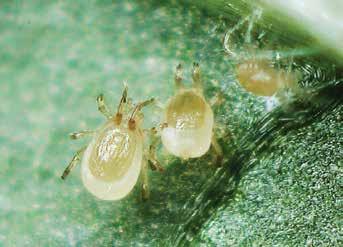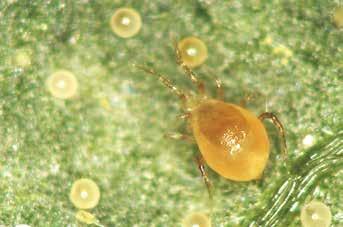
7 minute read
Mite Control
Selection Factors
INFESTATION
To determine your plan of action, it is critical to know the level and spread of the pest infestation. For high or established infestations, a knockdown spray may be necessary PRIOR to introducing predatory insects or mites. Know your state regulations and consider choosing a non-synthetic or biorational solution (see pages 33-40).
TIMING
Timing is everything. Applying compatible or soft sprays can help to bring pest populations down to a level in which predator introductions can thrive. When using sprays make sure there are no residual effects that will harm predators. Many biological sprays can be used in conjunction with predators, and cause no harm to their populations.
DELIVERY
Predatory mites are available in several types of delivery methods, including bulk tubes and bags, sachets, mini sachets and sachets on sticks. Bulk deliveries are cost-effective and good for targeting hot spots. Sachets offer continuous release over time for preventative and ongoing control within the plant canopy.
CONTINUITY
A single application of predatory insects will likely not provide the rate of consumption to compete with rapid pest reproduction rates. Repeated applications on a schedule allows for introduction of additional predators while others transition through life stages. Preplanned insect programs allow for growers to maintain consistent application schedules, avoiding surprise breakouts.
Damage & Symptoms
Spider Mites
Webbing, leaf edges curling or burned, slowed growth, speckled, leathery golden leaves.
Russet Mites
Leaflets curl, chlorosis, necrosis, lower leaves dry out, leaves look bronze in color.
Broad Mites
Flowers can wither, distorted leaves, leaves curled inward, dark & streaked foliage, compact leaf masses.


Mite Predator Species Ideal Conditions Mite Predator Application Application Rate Notes
Amblyseius andersoni 43-100°F (68-77°F to hatch) 1 sachet per plant or tray, 3-5 mites per 10 sq. ft. Best used preventively.
Amblyseius swirskii 68-95°F, 70% RH 10 per sq. ft. biweekly - weekly propagation Active down to 60°F. Very voracious predator. Eliminate excess webbing or honeydew.
Galendromus occidentalis 75-110°F, 35-60% RH 1,000 per 500 sq. ft. indoors, 2,000-5,000 sq. per acre biweekly Best for warm and dry climates. If used indoors, humidity must be higher than 30%.
Mesoseiulus longipes 65-90°F, 45-65% RH 1,000 per 300 sq. ft. 3-5 times biweekly Indoors only - warmer climates.
Neoseiulus (=Amblyseius) californicus 70-90°F, 40-65% RH 1-2 sachets or 1-4 mites per plant Use weekly until infestation subsides.
Neoseiulus (=Amblyseius) fallacis 60-85°F, 60-80% RH 2-5 per sq. ft. Excellent dispersal ability. Works well for broad and russet mites.
Phytoseiulus persimilis 68-90°F, 60-90% RH 2+ mites per sq. ft. every 7-14 days Can compete with cucumeris after knockdown spray. . Use 48 hours
Feltiella acarisuga 68-80°F, 50-80% RH 1 per sq. ft. weekly, 3 weeks min. Eggs and larvae cannot survive temps above 86°F and below 30% RH
Stethorus puctillum 67-90° F, 30-90% RH 3-4 per 10 sq. ft., 100-200 per hot spot weekly for 4 weeks Larvae and adults feed on mites. For best results use with persimilis.
Mite Predator - Amblyseius andersoni
Great For Pre-Emergent Control Of Pest Mite Infestations!
TARGET: Various pest mites including broad mites, cyclamen mites, two-spotted spider mites, red spider mites, tomato russet mites and rust mites. DESCRIPTION: This predatory mite is less than 1mm long and light brown. Adult females lay about 35 eggs in a lifetime, arranging eggs onto leaf hairs. This predatory mite feeds on all stages of pest mites, thrips, pollen and honeydew. SUGGESTED USE (Depending upon level of infestation): For best results, apply as a preventative treatment of mite infestations. Sachets allow for controlled release of mites over 4-6 weeks. Apply at a rate of 1-2 mites per sq. ft. or 1 sachet per plant. Place sachets within plant canopy. Use sachets on sticks at 1 per propagation tray or where canopy cannot hold sachet on hook. Replace sachets every four weeks for continued control. Temperature: Moderate 42-100ºF Relative Humidity: High if in higher temps.
BULK SIZES:
1101324 ≈25,000 in Tube $140.00 1101327 ≈50,000 in 1 Liter Bottle $165.00 1101321 ≈125,000 in 5 Liter Bag $375.00
CONTROLLED RELEASE:
1101323 ≈25,000 in 200 Mini Sachets w/Hooks $160.00 1101350 ≈25,000 in 200 Mini Sachets on Sticks $175.00 1101325 ≈62,500 in 250 Sachets w/Hooks $225.00 1101355 ≈125,000 in 1,000 Mini Sachets on Sticks $700.00 1101322 ≈125,250 in 6 x 328 ft. Strips of Sachets $670.00
Overnight Shipping Required
Amblyseius andersoni
Spider Mite Destroyer - Feltiella acarisuga

We Recommend This Predator When Spider Mite Infestations Are Widespread.
TARGET: Two spotted spider mites, carmine spider mites, European red mites; various mites. DESCRIPTION: The larvae of this tiny gall-midge Feltiella acarisugafeeds on two-spotted spider mites and various other species of spider mites. Recommended to be used with P. persimilis when spider mite infestations are severe to rapidly knock back the pest mites. Feltiella works best on plants that have hairy stems. Adults do not prey on spider mites, but search for colonies and deposit eggs next to them. Eggs hatch in 2 days and larvae feed on all stages of spider mites for 4-6 days. The entire life cycle is about 15 days. SUGGESTED USE (Depending upon level of infestation): For light infestations, introduce <1/1,000 sq. ft. or 500/acre every 7 days, for at least 3 weeks. For heavy infestations, introduce 2-3/1,000 sq. ft. or 1,000/acre every 7 days, for at least 3 weeks. Temperature: Moderate 60-77ºF Relative Humidity: High 50-90% 1155701 ≈250 Count $144.00
Overnight Shipping Required
Mite Predator - Neoseiulus
(=Amblyseius) californicus
Good For Areas Where Temperatures Fluctuate Greatly Such As Deserts.
TARGET: Various spider mites, cyclamen mites, broad mites and russet mites.
DESCRIPTION: This tiny, ivory, pear-shaped predatory mite feeds on a variety of pests on crops including: cucumbers, tomatoes, strawberries, tropical foliage plants, and greenhouse roses. Although adults consume prey at a relatively slow rate of about one egg per day, they can survive longer under starvation conditions. During their lifetime of about 20 days, females will lay approx. 1-3 eggs per day. Eggs hatch within a few days and adulthood is reached in about 4-12 days. SUGGESTED USE (Depending upon level of infestation): Use ≈1,000 per 4,500 sq. ft. in greenhouses to treat for broad mite. Use ≈10,000 per acre to treat for cyclamen mites on strawberries. Use weekly until infestation subsides. Temperature: Warm 50-105ºF Relative Humidity: 40-80%
BULK SIZES:
1151214 ≈1,000 in Blister Pack $20.00 1151213 ≈2,000 Count $43.00 1151209 ≈5,000 Count $65.50 1151210 ≈10,000 Count (2 x 5,000) $106.00 1151212 ≈25,000 Count $128.00 1151285 ≈100,000 Count (4 x 25,000) $350.00
CONTROLLED RELEASE:
1151216 ≈10,000 - 100 Sachets w/Hooks $75.00 1151271 ≈25,000 - 100 Sachets w/Hooks $162.00 1151215 ≈25,000 - 200 Sachets w/Hooks $170.00 1151275 ≈25,000 - 200 Sachets w/Sticks $190.00 1151217 ≈50,000 - 500 Sachets w/Hooks $250.00 1151273 ≈125,000 - 500 Sachets w/Hooks $312.50 1151278 ≈125,000 - 6 x 328 ft. Sachet Strips $650.00 1151279 ≈250,000 - 500 Sachets w/Hooks $350.00
Overnight Shipping Required
Neoseiulus (=Amblyseius) californicus
Phytoseiulus persimilis PLUS (see page 11)
Mite Predator - Phytoseiulus persimilis TARGET: Two spotted spider mites and various other mites.

DESCRIPTION: These predatory mites have high consumption rates, feeding on approx. 5-20 pests and pest eggs per day! Females will lay about 60 eggs throughout their 50-day lifespan. They will not enter a diapause stage in enclosed or greenhouse settings; making them active year round. Adults will begin feeding as soon as they are applied. P. persimilis PLUS is reared in an innovative way to include mobile mites (adults and juveniles) as well as eggs. P. persimilis PLUS arrives pale and changes to orange/red after predation begins. Adults begin feeding upon dispersal. Eggs can mature in about a week (at temps between 70-80°F). The variety of life stages allow for both immediate and ongoing control as the mites mature.
P. persimilis PLUS Sachets
PLUS Controlled Release sachet mites emerge between 8 -12 days after application. Best for preventative use. PLUS RAPID Release sachets are used for hot spot treatment with emergence around 3-5 days.
SUGGESTED USE (Depending upon level of infestation):
Bulk Sachets
Low Infestation 1-3 Mites per sq.ft. 1 Controlled Release Sachet per 50 sq.ft. Moderate Infestation/ Speckling 5+ Mites per sq.ft. 1 Rapid Release Sachet per 20 sq.ft.
Webbing/Outbreak 10+ Mites per sq.ft. after knockdown/cleaning 1 Rapid Release Sachet per 10 sq.ft.
Outdoor Crops
Clones
20,000 - 200,000 Mites per acre depending on infestation level 1 Sachet per plant
Temperature: Moderate: 68-90°F Relative Humidity: High: 60-90%
P. PERSIMILIS PLUS BULK SIZES:
1151250 PLUS ≈2000 Bottle 1151251 PLUS ≈4000 Bottle 1151252 PLUS ≈10,000 Bottle 1151253 PLUS ≈20,000 Bottle
$23.00 $40.00 $85.00 $120.00
P. PERSIMILIS PLUS CONTROLLED RELEASE:
1151235 PLUS ≈5,000 in 50 sachets w/hooks $50.00 1151236 PLUS ≈10,000 in 100 sachets w/hooks $95.00 1151230 PLUS ≈25,000 in 250 sachets w/hooks $225.00 1151231 PLUS ≈50,000 in 500 sachets w/hooks $387.50
P. PERSIMILIS PLUS RAPID RELEASE:
1151245 PLUS RAPID ≈5,000 in 50 sachets w/hooks $50.00 1151246 PLUS RAPID ≈10,000 in 100 sachets w/hooks $95.00 1151240 PLUS RAPID ≈25,000 in 250 sachets w/hooks $225.00 1151241 PLUS RAPID ≈50,000 in 500 sachets w/hooks $387.50




